
The Himalayas of India: Ladakh and Dharamsala,
Summer 2008
Himachal Pradesh - The Old British Church, Dip Tse Chok Ling, Tibetan Music, The Tibet Connection
Page 13 of 16
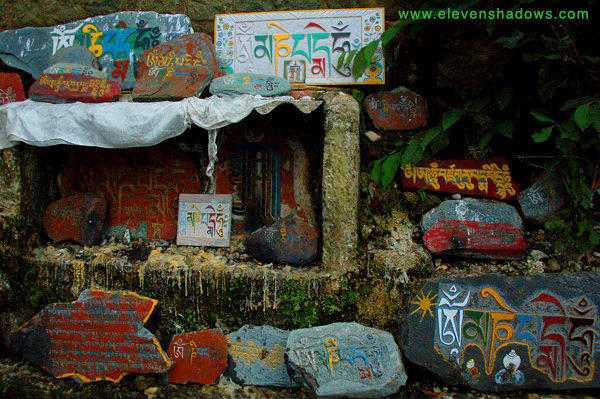 These
are the many mani stones and melted wax from candlelight vigils near the
Dalai Lama's temple on Temple Road in Dharamsala. These
are the many mani stones and melted wax from candlelight vigils near the
Dalai Lama's temple on Temple Road in Dharamsala.~~ Rebecca and I left the Japanese restaurant as the skies opened up its monsoon fury upon the earth. This was a relentless, windy deluge. And from this, I learned a valuable lesson: don't leave your hotel with the window open during monsoon season. Sure, I had a two meter overhang and balcony on both sides, but no matter. My bed and floor were soaked, the cloudburst so powerful that it had jammed its way underneath the closed balcony door! |
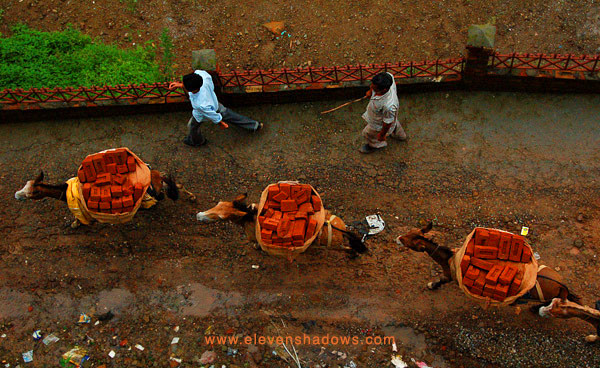 Beasts
of burden, assisting with the constant construction in McLeod Ganj.
Tourism is big, and McLeod Ganj seems ten times more built up than the small
area should be. Beasts
of burden, assisting with the constant construction in McLeod Ganj.
Tourism is big, and McLeod Ganj seems ten times more built up than the small
area should be. |
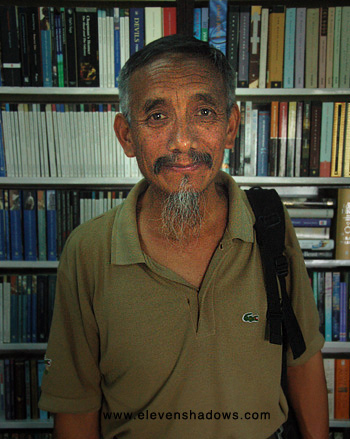 After
torrent of rain subsided, I walked over to Bookworm on Hotel Bhagsu Road.
Lhasang Tsering was minding the store. I liked him. I could see
he was
opinionated and short-tempered, but intelligent, with a sense of humor and graciousness
as well. I had been to the store before setting out for Chamba,
purchasing "Tibet: The Issue Is Independence" by Edward Lazar, and was
looking at a book by Jamyang Norbu, another outspoken Tibetan author. After
torrent of rain subsided, I walked over to Bookworm on Hotel Bhagsu Road.
Lhasang Tsering was minding the store. I liked him. I could see
he was
opinionated and short-tempered, but intelligent, with a sense of humor and graciousness
as well. I had been to the store before setting out for Chamba,
purchasing "Tibet: The Issue Is Independence" by Edward Lazar, and was
looking at a book by Jamyang Norbu, another outspoken Tibetan author.Sparked by these book selections, Lhasang and I had a long conversation. We both felt that for Tibet, full independence was the ONLY option. In their decades of occupation of Tibet, Beijing has never once shown any desire to discuss a compromise solution - not even the most weak-kneed compromises offered by the Tibetan government-in-exile. The only statement Beijing has ever issued where they specifically mentioned what they were prepared to discuss was by Hu Yaobang in 1984, which only dealt with the finer details of the Dalai Lama's return to the "Motherland" after he had given up independence. And in Tibet, given the continued military lockdown since March 2008, the unabated imprisonment and torture, the barring of foreign press, the lack of freedom of expression or religion, and the racism and contempt that the Chinese have shown Tibetans, why would anyone in their right mind ever think that Beijing was open to compromise on any level? Does this seem like a policy that's open to creating a "Zone of Peace" in Tibet? They've not shown any willingness to compromise to the Uighurs or any other "minority peoples", so why would they break from tradition in Tibet? Meanwhile, Beijing continues to offer financial incentives to increase Chinese immigration to Tibet, making Tibetans a minority people in their own country. Railroads, highways, all leading to Tibet, greases the wheels for this influx. And not once as Beijing ever indicated that they would ever halt the influx of people that is destroying a way of life for all Tibetans, whether Tibet rejoined the "Motherland" or not. The issue here is the survival of the Tibetans, and clearly the only hope for this is by full independence. The Soviet Union crumbled, the Berlin Wall came down, South Africa's apartheid had abated. And these situations changed dramatically, almost seemingly overnight. And if this can occur with Tibet, it won't be easy, and it won't be pretty, and it probably won't be any time soon. But it could occur. Many of us want the other side of Tibet. We want to bask in the healing glow of their message of global unity, interdependence, compassion for all sentient beings, for being intrinsically good, for inner calm. I want that. You want that. We all want that. But we don't want to get our hands messy in the "politics" of it. But you can't have one without the other. Tibetans are certainly happy that much of the world embraces their message of spirituality, but what they want and need right now is for the world to get involved in saving them as a people. |
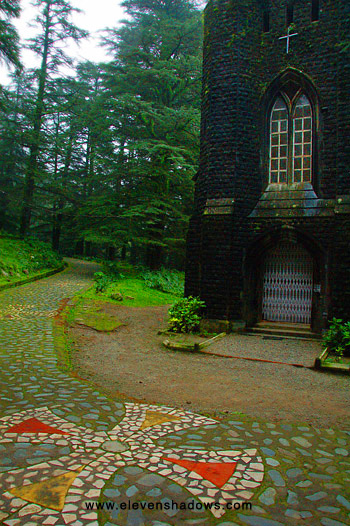 25
July - I called Lisa this morning. She was crying. Our cat
Waylon's condition had deteriorated considerably. He had blood
in his urine, wasn't eating, wasn't drinking. She had no choice but to put
him to sleep. What a terrible, difficult decision she had to make.
But we knew he was no longer suffering. Waylon was a great cat who simply
assumed that everyone should love him, and he will be deeply missed. 25
July - I called Lisa this morning. She was crying. Our cat
Waylon's condition had deteriorated considerably. He had blood
in his urine, wasn't eating, wasn't drinking. She had no choice but to put
him to sleep. What a terrible, difficult decision she had to make.
But we knew he was no longer suffering. Waylon was a great cat who simply
assumed that everyone should love him, and he will be deeply missed.I walked down to the Dalai Lama's temple again. I made another offering to Avolokiteshvara to help Waylon navigate the Cat Bardo. It couldn't hurt, right? I then spun all the prayer wheels while making three trips around the temple.
26 July - I talked to Lhasang Tsering at Bookworm again. I asked him, "What the best thing to do for Tibetan independence, or to help Tibetans, for those of us who are far away?" He noted in his answer that this was indeed a two-pronged question. His suggestion for independence was to try and make the Dalai Lama and the Tibetan government-in-exile realize that full independence is the only way to preserve Tibet. And he added, "The Dalai Lama might listen to someone who is outside more than he would to an ordinary Tibetan like myself." As for helping Tibetans, he felt that much of what was being done already was good, just more of it. Educating Tibetans, volunteering. ~~ After visiting Lhasang, I walked over to St. John in the Wilderness, a pretty church, and an evocative reminder of when Dharamsala was a British hill station. It's an Anglican church built in the mid 1800s. Its churchyard is the final resting place of Lord Elgin, a British Viceroy of India during the 19th century. |
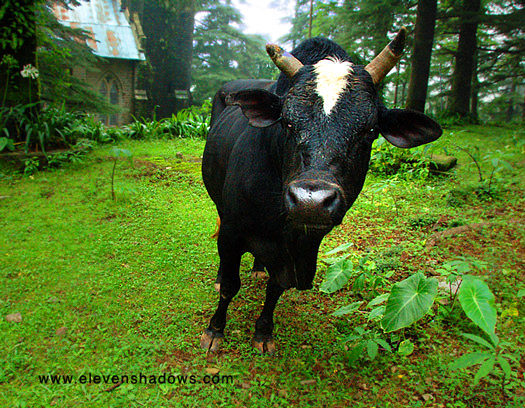 Much
like the photo of Tibetan prayer flags hung over the front of the mosque
on Page 6, this photo of
a cow munching grass in the churchyard of St. John in the Wilderness
illustrates the cultural and religious diversity within India's borders. Much
like the photo of Tibetan prayer flags hung over the front of the mosque
on Page 6, this photo of
a cow munching grass in the churchyard of St. John in the Wilderness
illustrates the cultural and religious diversity within India's borders. |
 Mossy
cross. Mossy
cross.From St John in the Wilderness, I could see the bright roof of Dip Tse Chok Ling Monastery, and decided to walk over there. |
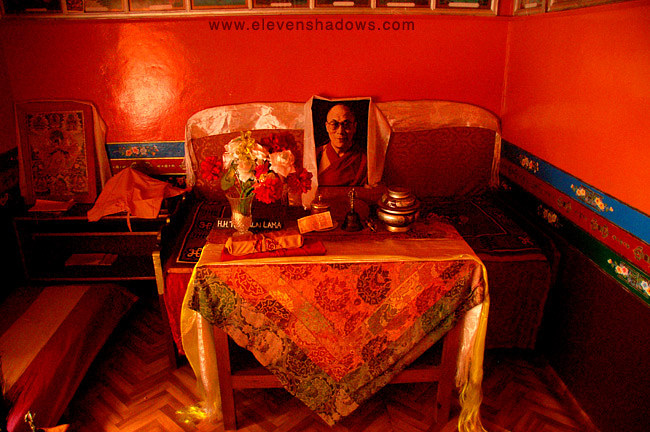 From
Temple Road, it's a short walk down a narrow lane and some steep steps to
Dip Tse Chok Ling Monastery, which to me sounds like "Dipped in Chocolate
Monastery." This is the room where the Dalai Lama sleeps when he stays
at Dip Tse Chok Ling. From
Temple Road, it's a short walk down a narrow lane and some steep steps to
Dip Tse Chok Ling Monastery, which to me sounds like "Dipped in Chocolate
Monastery." This is the room where the Dalai Lama sleeps when he stays
at Dip Tse Chok Ling.
|
 Housed
in Dip Tse Chok Ling are some interesting butter sculptures. The
butter is mixed with wax and sculpted. They are made during Losar
(Tibetan New Year) and then destroyed during the following Losar to signify
the impermanence of things. Housed
in Dip Tse Chok Ling are some interesting butter sculptures. The
butter is mixed with wax and sculpted. They are made during Losar
(Tibetan New Year) and then destroyed during the following Losar to signify
the impermanence of things. |
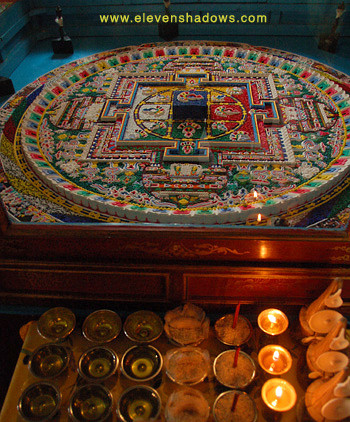 Also
in Dip Tse Chok Ling Monastery are some finely detailed sand mandalas.
Completing a mandala can take as long as a week, with several monks working
in shifts. The sand is poured through a small funnel that permits the
flow of only a few grains of sand at a time onto a board on which the
mandala design has been drawn. Also
in Dip Tse Chok Ling Monastery are some finely detailed sand mandalas.
Completing a mandala can take as long as a week, with several monks working
in shifts. The sand is poured through a small funnel that permits the
flow of only a few grains of sand at a time onto a board on which the
mandala design has been drawn. |
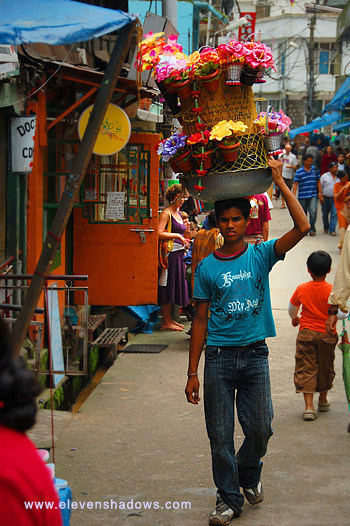 After
visiting the Dip Tse Chok Ling, I began walking to Carpe Diem restaurant.
On the way, I photographed this flower vendor walking up Jogibara Road.
There had been recent terrorist bombings in Bangalore and Ahmedabad, and the
country was tense from the news. Some suspected that the bombs had
been brought in through flower pots. I walked past, hoping for none of
those dreaded exploding flower pots. After
visiting the Dip Tse Chok Ling, I began walking to Carpe Diem restaurant.
On the way, I photographed this flower vendor walking up Jogibara Road.
There had been recent terrorist bombings in Bangalore and Ahmedabad, and the
country was tense from the news. Some suspected that the bombs had
been brought in through flower pots. I walked past, hoping for none of
those dreaded exploding flower pots.Sitting down at Carpe Diem restaurant, I began talking with a young woman from Oregon named Katie, who I had seen coming up the slippery stairs of the monastery just a short while ago. She asked, "What do you think of Obama choosing Hillary Clinton as a running mate?" I was alarmed. "Whaaat? I've never heard this!!" "Oh, yes," she replied, "this happened about three weeks ago." I didn't know what to make of that. I was stunned. I'd never been a Hillary Clinton fan. I found out several days later that this arrangement was not true. I was hungry for food from my homeland. That, of course, would be Mexican food. I knew it'd be different up here in the Himalayas. And opening the menu confirmed that it'd be. Under the "Mexican Food" heading on the menu, two of the choices were moussaka!! I ordered the chicken and mushroom enchilada. It was tasty, if not quite Mexican tasting. I washed this down with some delicious apple ginger juice. |
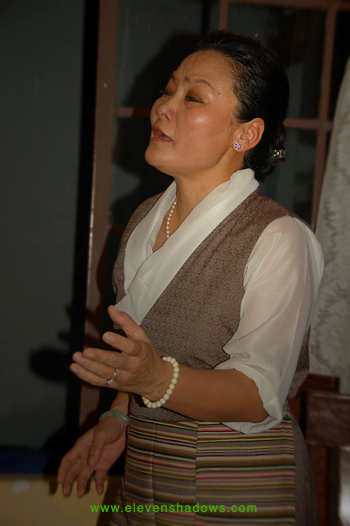 Later
that evening, I attended a music performance at Pema Thang Restaurant, meeting
Rebecca from
The Tibet Connection and her friend Julie there. Later
that evening, I attended a music performance at Pema Thang Restaurant, meeting
Rebecca from
The Tibet Connection and her friend Julie there.Kelsang Chukie Tethong, a gifted soprano Tibetan singer, has lent her voice to "Dreaming Lhasa" and played Milarepa's mother in the film "Milarepa". She performed here with some traditional Tibetan musicians. And if that weren't enough, she also co-owns Pema Thang Hotel and Restaurant. We were also treated to a Tibetan food buffet and some good twangy foot-stomping Tibetan music as well as Kelsang's lovely voice. |
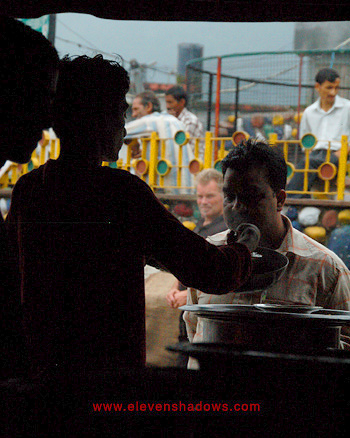 27
July - The next morning, I walked down Jogibara Road to Ronnie and Rebecca's
house, not far from the Delek Hospital and the Tibetan government
buildings. As usual, both had many projects going, not just
The Tibet Connection work. They had some projects in the works for
the winter, one involving filming and interviewing for several weeks in freezing altitudes above 3600m
(12000 ft.). 27
July - The next morning, I walked down Jogibara Road to Ronnie and Rebecca's
house, not far from the Delek Hospital and the Tibetan government
buildings. As usual, both had many projects going, not just
The Tibet Connection work. They had some projects in the works for
the winter, one involving filming and interviewing for several weeks in freezing altitudes above 3600m
(12000 ft.).We walked down to Kotwali Bazaar in Dharamsala to eat some food at an Indian dhaba and then came back up to their home. |
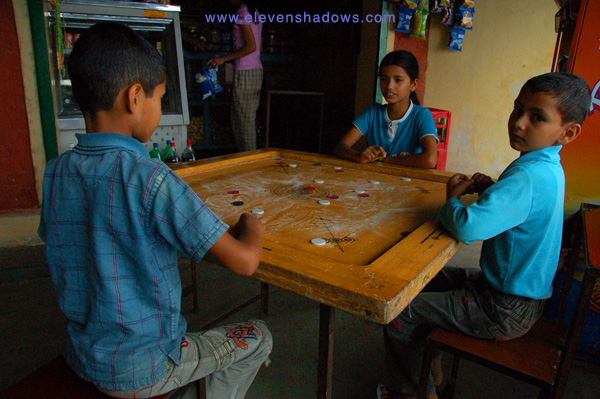 Ronny
and Rebecca have a friend named Ravi, who owns a tea shop not far from where
they live. And here, some kids played a traditional game called carrom
(karam, karom), not unlike pool conceptually, but with disks instead of
balls. It's sort of a cross between billiards and table shuffleboard. Ronny
and Rebecca have a friend named Ravi, who owns a tea shop not far from where
they live. And here, some kids played a traditional game called carrom
(karam, karom), not unlike pool conceptually, but with disks instead of
balls. It's sort of a cross between billiards and table shuffleboard. |
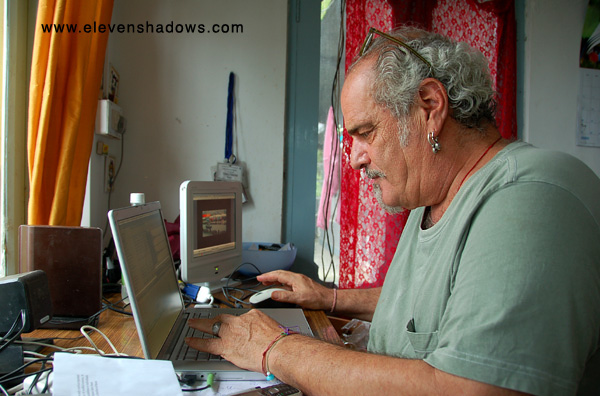 Ronny
editing a documentary film at what we'll call "TC East", or the East
Headquarters of
The Tibet Connection. Ronny
editing a documentary film at what we'll call "TC East", or the East
Headquarters of
The Tibet Connection. |
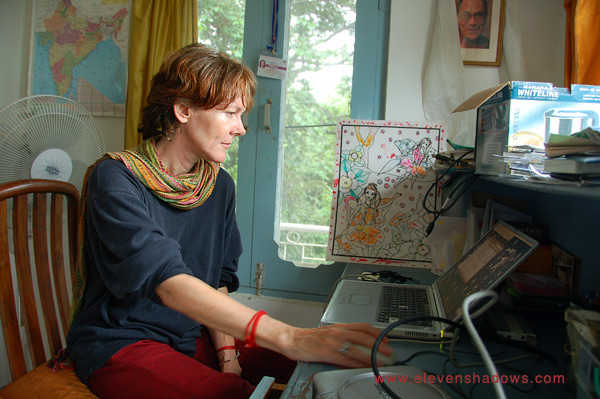 And
Rebecca writing another poignant article for the Huffington Post in her spare
time, when she's not working on The Tibet Connection or 108 other projects. And
Rebecca writing another poignant article for the Huffington Post in her spare
time, when she's not working on The Tibet Connection or 108 other projects. |
The Himalayas of India: Ladakh and Dharamsala, Summer 2008
Page 13 of 16
1 2 3 4 5 6 7 8 9 10 11 12 13 14 15 16
Eleven Shadows Travel Page
Contact photographer/musician Ken Lee